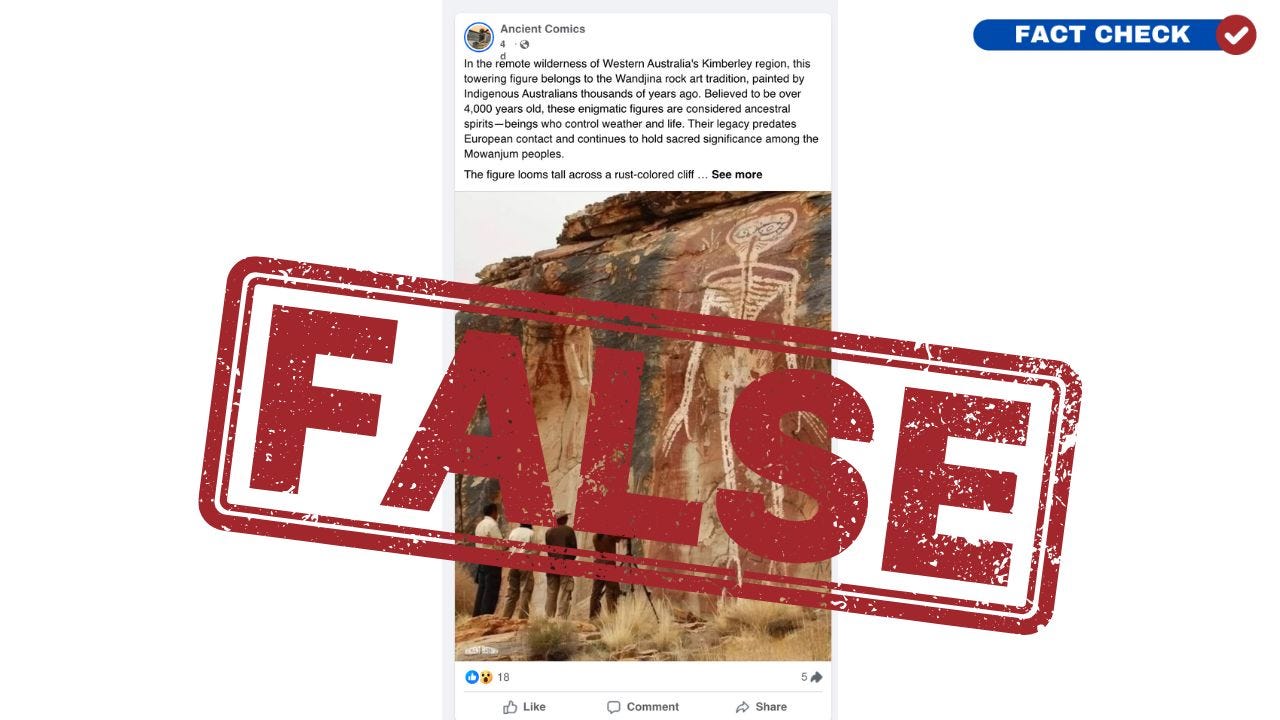AI-generated Aboriginal art fakes 'disrespectful and upsetting'
By Nik Dirga in Auckland
WHAT WAS CLAIMED : An image shows giant Aboriginal rock art in Western Australia.
OUR VERDICT : False. The image appears to be AI-generated and the artwork does not match traditional work in the region, experts say.
AI-generated 'Aboriginal rock art' is being falsely portrayed on social media as depicting the creation spirit Wandjina.
The image, shared on several 'history'-themed Facebook pages, shows four people at the bottom of a large sandstone rock face, where artwork about six metres high of a tall thin figure is visible.
The caption reads: "In the remote wilderness of Western Australia's Kimberley region, this towering figure belongs to the Wandjina rock art tradition, painted by Indigenous Australians thousands of years ago."
However, experts and a local Indigenous artist said the image bears no resemblance to other Indigenous depictions from the region.
The artwork also bears telltale signs of being created with artificial intelligence (AI), including a person with an implausibly long right arm holding a camera and the group's oddly blurred facial features.
Wandjina (also called Wanjina) is a creation spirit associated with rain, the Japingka Aboriginal Art Gallery explains.
It is a sacred being to the Worrora, Ngarinyin and Wununbul people.
Ngarinyin Worrorra woman Kirsty Burgu, an Indigenous artist living at the Mowanjum community in the Kimberley region, told AAP FactCheck she believes the image is fake.
"It just doesn't look anywhere near Wandjina, because the design, everything about it, doesn't represent any of our paintings," she said
She pointed to discrepancies such as the image having six fingers and knuckles, while the halo around the head representing cumulus clouds was absent.
It was disrespectful and upsetting for Indigenous people to see a sacred being misused, Ms Burgu added.
University of Western Australia (UWA) archaeologist and rock art expert Sven Ouzman told AAP FactCheck the image is clearly fake.
"If this image was genuine, you'd have academics rushing to publish it … it's noticeable all the mentions of it are from non-academic sources," he said.
Griffith University archaeologist Lynley Wallis agreed the image is fake.
"This is not a real photo of Kimberley rock art and has been debunked by UWA archaeologists already," she said.
Reverse image searches only turned up links to social media posts making these claims about the image.
Professor Wallis said the fake art was also discussed on the Ozarch Australian archaeology forum, with archaeologist Denis Grojak noting the number of "AI-based faked images" proliferating on Facebook.
Mr Grojak also pointed out that "evidently, even rock art fakes have problems with the number of fingers they depict", referring to the tendency for AI-generated images of humans to feature inaccurate hands - the figure in the fake rock art picture appears to have too many fingers on one side.
Associate Professor Ouzman said the AI image did not match up with what is usually seen in Wandjina.
"The iconic Wandjina/Wanjina ancestral beings (what non-Worroran people call 'images' or 'rock art') typically occur inside rock shelters, not on open exposed rock surfaces like in the internet AI image, and are often on a white prepared paint background."
He explained that legitimate work often features a large, rayed head, sometimes with cockatoo feathers, large eyes, no mouth, fairly square shoulders and a large, usually decorated, body with short arms and legs - none of which appear in the viral image.
Several authentic samples of Wandjina also appear on the Japingka Aboriginal Art website.
Wandjina can be large, up to 4m, Assoc Prof Ouzman explained, but would be typically placed horizontally in rock shelters.
Painted work exposed to the elements, as in the viral image, would also be very unlikely to have lasted for thousands of years, he said.
It's also been claimed the picture, sometimes flipped so it's a mirror image, shows an ancient discovery in India, as seen in posts on Facebook, TikTok and YouTube.
Assoc Prof Ouzman said it's not an "image" to its makers and custodians but an actual ancestral being on/in the rock.
"Misrepresenting Wandjina/Wanjina does violence to the being and this relationship," he said.
"As a living tradition, AI misuses like this cause very real distress to Worroran people, so comes at a real personal and societal cost."
The same rock art image has also been fact-checked by Agence France-Presse.
AAP FactCheck is an accredited member of the International Fact-Checking Network. To keep up with our latest fact checks, follow us on Facebook, Instagram, Threads, X, BlueSky, TikTok and YouTube.
At Mencari, we think it's super important to fact-check to fight misinformation and disinformation and to keep citizens and voters informed and educated.
We invite the public to send us their feedback and requests for fact-checks at factcheck@readmencari.com.
Got a News Tip?
Contact our editor via Proton Mail encrypted, X Direct Message, LinkedIn, or email. You can securely message him on Signal by using his username, Miko Santos.
As well as knowing you’re keeping MENCARI alive, you’ll also get:
Get breaking news AS IT HAPPENS - Gain instant access to our real-time coverage and analysis when major stories break, keeping you ahead of the curve
Unlock our COMPLETE content library - Enjoy unlimited access to every newsletter, podcast episode, and exclusive archive—all seamlessly available in your favorite podcast apps.
Join the conversation that matters - Be part of our vibrant community with full commenting privileges on all content, directly supporting Mencari's
It only takes a minute to help us investigate fearlessly and expose lies and wrongdoing to hold power accountable. Thanks!






